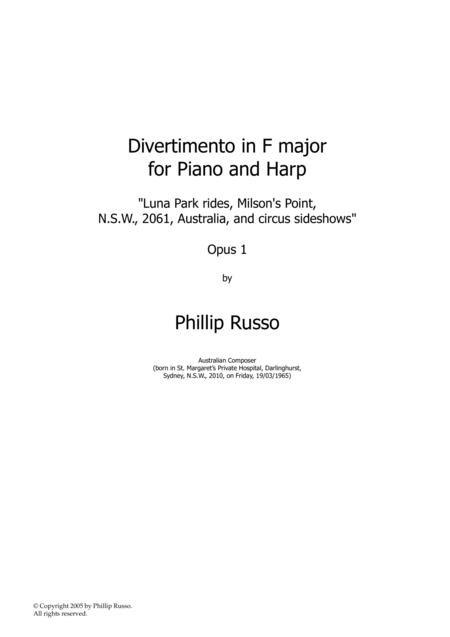Chamber Orchestra - Level 3 - Digital Download SKU: A0.1027281 Composed by Australian neo-classical composer, Mr. Phillip Anthony Russo, and born 19/03/1965. Classical,Contemporary,Instructional,Standards,World. Score and parts. 56 pages. Mr. Phillip Anthony Russo #2029033. Published by Mr. Phillip Anthony Russo (A0.1027281). Divertimento in F major for Piano and Harp, Opus 1. Copyright, 2005, 2010, 2014, by Phillip Russo, born 19/03/1965. All Rights Reserved. This beautiful, melodious and fun piece, which plays for 12 minutes and 17 seconds on the CD, is scored in a bright F major key, has two sections in C major, and employs 43 orchestral instruments, played by 40 musicians. Two percussionists play five instruments. The pianist directs and conducts the work from the piano, or a conductor may be employed instead. I chose a concert grand piano, or a baby grand piano, and a concert harp as the two leading, but not solo, orchestral instruments which are used to showcase the piece. I have included a .mp3 audio clip of this piece to illustrate the neo-classical melodies in it. Divertimenti, were first written by Franz Joseph Haydn, Michael Haydn and Wolfgang Amadeus Mozart during the Classical period, between 1750 and 1809. A divertimento is a short, entertaining, chamber ensemble or orchestral work, usually in the form of an orchestral suite, written in several sections and/or movements. It can have as few as three, or many more instruments! A divertimento does not have a strict format, but a liberal one, within acceptable limits or conventions, and only small chamber ensembles were employed to perform divertimenti in Haydn's and Mozart's day in the eighteenth century. Both a divertimento and a cassation may contain a leading or obbligato instrument(s), or can even be integrated with vocal or choral music. However, divertimenti and cassations never have solo instruments, as in a concerto. An Opus number 1, means that this is the first written work of a composer; opus 2 means the second work, and so forth. 'Opus' means a work, or composition. I sub-titled the piece: Luna Park rides, Milson's Point, N.S.W., 2061, Australia, and circus sideshows. I chose this sub-title because the work reminds me of my childhood days, of the rides at Luna Park, Sydney, such as the Merry-go-Round, the Ferris Wheel, the Cha-Cha, the Dodgem cars, the Rotor, the Mirror Maze, the slippery dips in Coney Island, the River Caves, the Ghost Train - burnt down presumably due to an electrical fault, in December, 1974, killing 7 people, the Giant Pendulum ride, the Giant Spider ride, the Big Dipper, later renamed the Wild Cat and later the Wild Mouse, which is actually a Roller-coaster ride. Some of the Harp part sounds like the movement of the Roller-coaster! Also, the work reminisces on my experience of the Sole Brothers' Circus sideshows, in 1977, such as the targeting games and prizes, and clowns sideshows, which my dad took me to see when I was about 12 years old.
